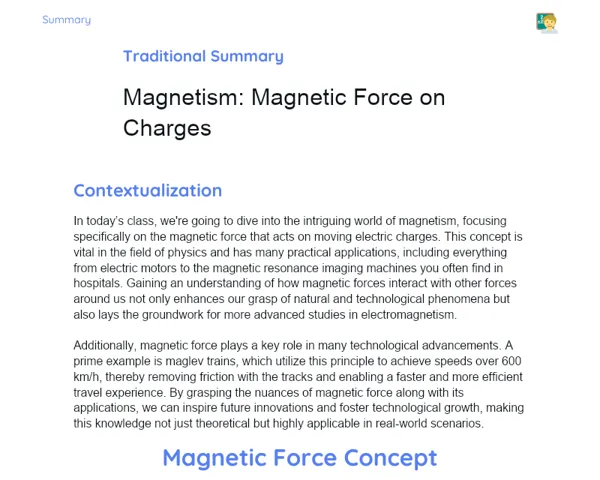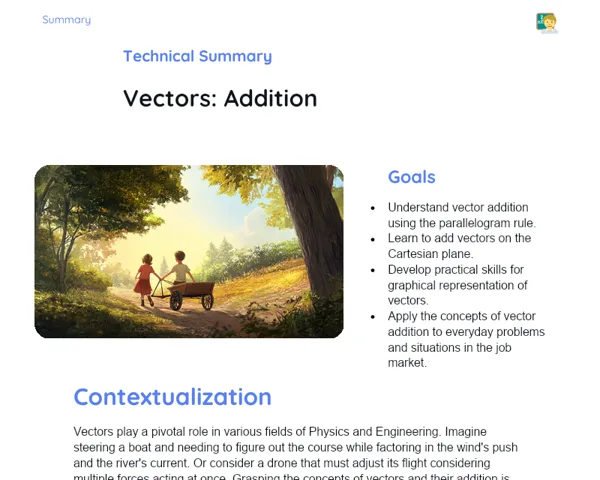Summary Tradisional | Dynamics: Newton's 1st Law
Contextualization
Newton's 1st Law, often called the Law of Inertia, is a key concept in classical mechanics put forth by Sir Isaac Newton in the 17th century. During this transformative period in science, understanding how objects move was crucial for explaining various natural phenomena. Newton established his three laws of motion to describe the behavior of objects under different forces, with the 1st Law emphasizing the tendency of objects to remain at rest or in uniform motion unless acted on by an external force.
We encounter Newton's 1st Law in our everyday lives quite frequently. For instance, think about riding a bus that brakes suddenly; your body lurches forward. This happens because of inertia—the resistance of objects to any change in their motion. This principle is vital in areas like traffic safety; for example, seatbelts are designed to counteract this inertia to keep passengers safe. Understanding this law is key to comprehending how objects interact in various contexts and ensures safety in our daily activities.
To Remember!
Inertia
Inertia is a fundamental property of matter that describes how a body resists changes in its state of motion. In simpler terms, an object tends to stay at rest or keep moving in a straight line unless influenced by an external force. This property is directly linked to the mass of the object; a heavier object has more inertia, meaning it resists changes in motion more than a lighter one does.
For example, if you push a car and a bicycle with the same force, the bicycle, being lighter, will move more easily compared to the heavier car, which will resist that push more. This reflects the principle of inertia.
Recognizing inertia is critical to understanding Newton's 1st Law, clarifying why bodies maintain their state of motion. This concept is used in fields like automobile engineering, where inertia is critical in designing safety systems.
-
Inertia is the resistance of a body to changes in its state of motion.
-
It is directly related to the mass of the body.
-
Fundamental for understanding Newton's 1st Law.
Newton's 1st Law
Newton's 1st Law, or the Law of Inertia, states that a body at rest will stay at rest, and a body in uniform motion will continue in that state unless acted upon by a non-zero net force. This law is crucial for classical mechanics as it establishes how bodies behave when there are no external forces acting on them.
For instance, consider a bus that suddenly brakes; you will feel pushed forward because your body wants to keep moving due to inertia. This law also explains why ach object remains stationary unless a force is applied.
Newton's 1st Law is essential for understanding the other two laws of motion and lays the groundwork for the study of dynamics. It enables us to predict how bodies will behave and how forces affect that behavior.
-
Newton's 1st Law is known as the Law of Inertia.
-
It states that a body remains in its state of motion or rest unless an external force acts upon it.
-
It is observable in everyday situations and is fundamental to classical mechanics.
Equilibrium of Forces
Equilibrium of forces occurs when the total forces acting on an object equal zero, leading to zero acceleration. This means if an object is stationary, it will remain at rest, and if it is in uniform motion, it will continue moving uniformly. For an object at rest, forces like gravitational force and normal force cancel each other out.
Think of a book resting on a table—the pull of gravity downward is countered by the table pushing upwards, resulting in no net force. Grasping this concept is vital for understanding both static and dynamic systems.
A good grasp of the equilibrium of forces is important for solving mechanics problems, as it allows us to predict how objects will behave in different contexts and correctly apply Newton's laws.
-
The equilibrium of forces occurs when the sum of the acting forces is zero.
-
Results in zero acceleration, keeping the body at rest or in uniform motion.
-
Essential for solving mechanics problems.
Practical Examples
Practical examples are crucial when illustrating how Newton's 1st Law applies to real-life scenarios. They help convert theoretical concepts into relatable understanding. For instance, being in a vehicle that suddenly brakes showcases inertia—passengers tend to continue moving even after the vehicle stops.
Consider a book resting on a table again. The gravitational force pulling it down is balanced by the normal force from the table pushing it up, keeping it stationary. Such examples help us visualize how Newton's 1st Law operates in our daily lives.
Simple demonstrations, like rolling a ball to show how it stays in motion until friction stops it, can significantly enhance students' comprehension of inertia across various contexts.
-
Practical examples make theoretical concepts more relatable.
-
Situations like sudden braking in a vehicle illustrate inertia.
-
Simple demonstrations help visualize Newton's 1st Law.
Problem Solving
Problem-solving involves applying Newton's 1st Law to interpret and predict how bodies will behave under various forces. This begins with identifying the forces acting on an object and finding out the net force. If the total of those forces is zero, the object is in equilibrium and will neither accelerate nor change its state of motion.
For example, when addressing a problem with an object at rest on an inclined surface, it is necessary to break down the forces into parallel and perpendicular components to that surface. The gravitational force can be divided into these components and should consider the normal and frictional forces to determine if the object will stay still or start moving.
Engaging in problem-solving assists students in solidifying their grasp of Newton's 1st Law while developing critical analytical thinking skills, which are essential for studying physics and all other scientific fields.
-
Problem solving applies Newton's 1st Law to understand the behavior of bodies.
-
Involves identifying acting forces and determining the net force.
-
Helps develop analytical and critical thinking skills.
Key Terms
-
Newton's 1st Law: Also called the Law of Inertia, states that a body does not change its state of motion unless an external force acts upon it.
-
Inertia: The property of a body to resist changes in its state of motion.
-
Equilibrium of Forces: Occurs when the sum of the forces acting on a body is zero, resulting in zero acceleration.
-
Net Force: The vector sum of all forces acting on a body.
-
Uniform Straight-Line Motion: Motion in a straight line with constant speed.
-
Gravitational Force: The attraction that Earth exerts on objects, pulling them downward.
-
Normal Force: The force that a surface exerts on an object, perpendicular to the surface.
-
Friction: The force that resists motion between two surfaces in contact.
Important Conclusions
In the lesson on Newton's 1st Law, we explored why this law, also known as the Law of Inertia, is foundational in classical mechanics. We learned that inertia is the resistance a body exhibits against changes in its motion, directly linked to the body's mass—larger bodies exhibit more inertia and hence, resist changes in their motion more effectively.
We discussed how Newton’s 1st Law articulates that a body at rest will stay at rest and a body moving uniformly will continue to do so unless a net force, unequal to zero, acts upon it. This principle is evident in daily life scenarios like sudden braking in a bus, which pushes passengers forward as a result of inertia.
We touched upon the equilibrium of forces, occurring when the total acting forces on a body add up to zero, leading to zero acceleration. A solid understanding of this equilibrium is crucial for successfully solving mechanics problems and applying Newton's laws in different contexts. Practicing real-world problems deepens theoretical knowledge and hones analytical and critical thinking skills.
Study Tips
-
Review the practical examples discussed in class and try to identify new everyday situations where Newton's 1st Law is evident.
-
Practice solving problems that require identifying and summing the acting forces on different objects to better understand equilibrium concepts.
-
Explore more about the other two laws of Newton's motion for a well-rounded understanding of classical mechanics.



